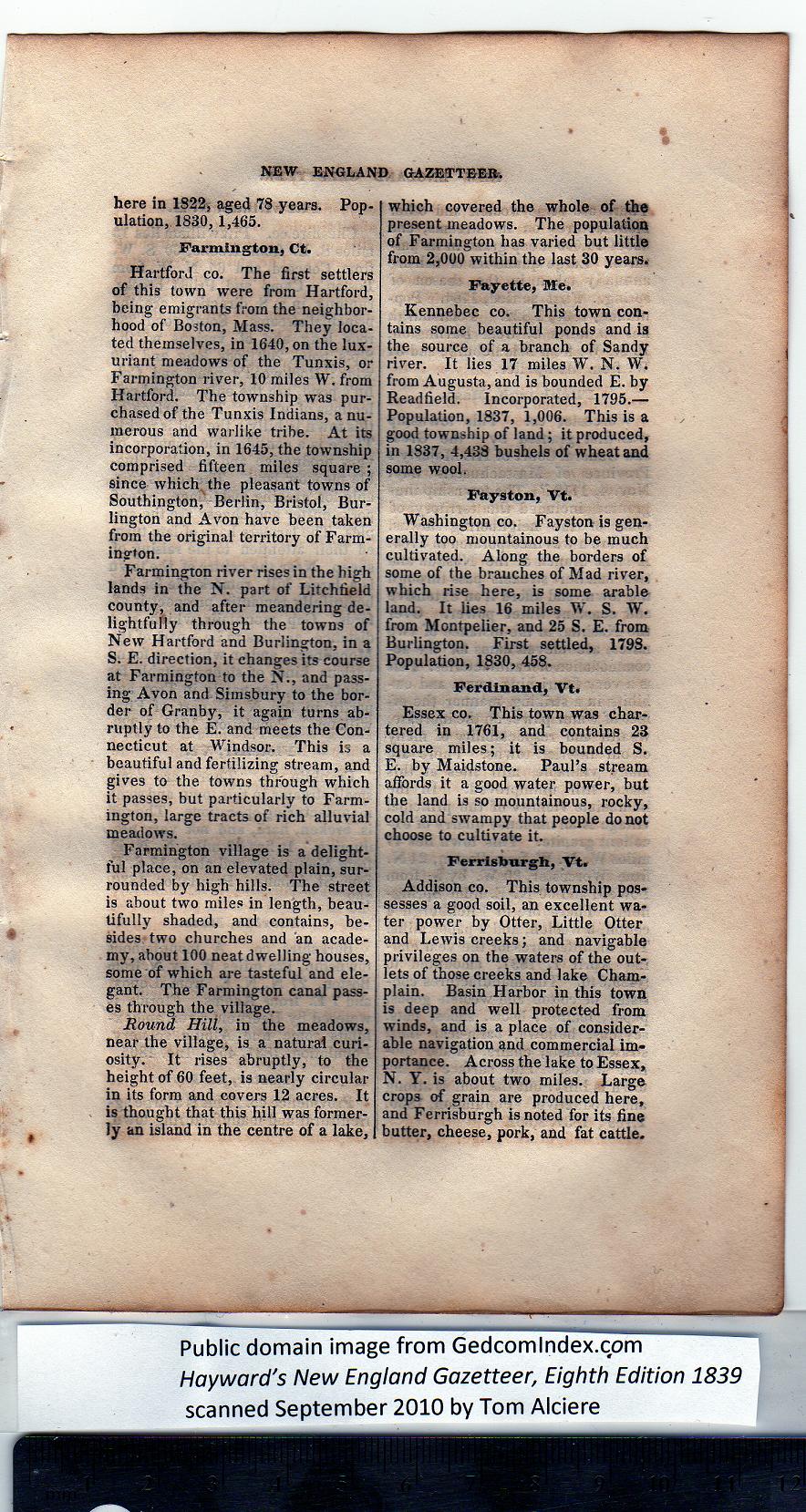|
here in 1S22, aged 78 years. Pop-
ulation, 1830, 1,465.
Farmington, Ct.
Hartford co. The first settlers
of this town were from Hartford,
being emigrants from the neighbor-
hood of Boston, Mass. They loca-
ted themselves, in 1640, on the lux-
uriant meadows of the Tunxis, or
Farmington river, 10 miles W. from
Hartford. The township was pur-
chased of the Tunxis Indians, a nu-
merous and warlike tribe. At its
incorporation, in 1645, the township
comprised fifteen miles square ;
since which the pleasant towns of
Southington, Berlin, Bristol, Bur-
lington and Avon have been taken
from the original territory of Farm-
ington.
Farmington river rises in the high
lands in the N. part of Litchfield
county, and after meandering de-
lightfully through the towns of
New Hartford and Burlington, in a
S. E. direction, it changes its course
at Farmington to the N., and pass-
ing Avon and Simsbury to the bor-
der of Granby, it again turns ab-
ruptly to the E. and meets the Con-
necticut at Windsor. This is a
beautiful and fertilizing stream, and
gives to the towns through which
it passes, but particularly to Farm-
ington, large tracts of rich alluvial
meadows.
Farmington village is a delight-
ful place, on an elevated plain, sur-
rounded by high hills. The street
is about two miles in length, beau-
tifully shaded, and contains, be-
sides two churches and an acade-
my, about 100 neat dwelling houses,
some of which are tasteful and ele-
gant. The Farmington canal pass-
es through the village.
Round Hilly in the meadows,
near the village, is a natural curi-
osity. It rises abruptly, to the
height of 60 feet, is nearly circular
in its form and covers 12 acres. It
is thought that this hill was former-
ly an island in the centre of a lake,
which covered the whole of the
present meadows. The population
of Farmington has varied but little
from 2,000 within the last 30 years.
|
Fayette, Hie.
Kennebec co. This town con-
tains some beautiful ponds and is
the source of a branch of Sandy
river. It lies 17 miles W. N. W.
from Augusta, and is bounded E. by
Readfield. Incorporated, 1795.—
Population, 1837, 1,006. This is a
good township of land; it produced,
in 1S37, 4,438 bushels of wheat and
some wool.
Fayston, Vt.
Washington co. Fayston is gen-
erally too mountainous to be much
cultivated. Along the borders of
some of the branches of Mad river,
which rise here, is some arable
land. It lies 16 miles W. S. W.
from Montpelier, and 25 S. E. from
Burlington. First settled, 179S.
Population, 1830, 458.
Ferdinand, Vt.
Essex co. This town was char-
tered in 1761, and contains 23
square miles; it is bounded S.
E. by Maidstone. Paul’s stream
affords it a good water power, but
the land is so mountainous, rocky,
cold and swampy that people do not
choose to cultivate it.
Ferrisburgh, Vt.
Addison co. This township pos-
sesses a good soil, an excellent wa-
ter power by Otter, Little Otter
and Lewis creeks; and navigable
privileges on the waters of the out-
lets of those creeks and lake Cham-
plain. Basin Harbor in this town
is deep and well protected from
winds, and is a place of consider-
able navigation and commercial im-
portance. Across the lake to Essex,
N. Y. is about two miles. Large
crops of grain are produced here,
and Ferrisburgh is noted for its fine
butter, cheese, pork, and fat cattle. |
